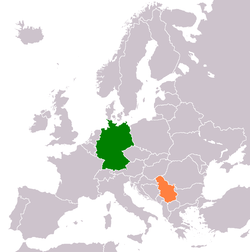Germany–Serbia relations
 | |
Germany |
Serbia |
|---|---|
Germany–Serbia relations are foreign relations between Germany and Serbia. Both countries established diplomatic relations on 18 January 1879. Germany has an embassy in Belgrade. Serbia has an embassy in Berlin and five general consulates (in Frankfurt, Hamburg, Munich, Stuttgart and Düsseldorf).[1][2] There are around 505,000 people of Serbian descent living in Germany.[3] Germany is a European Union member state and Serbia is a European Union candidate.
History

The origin of Serbian-German relations can be traced to the
Culture of Serbs in
The Principality and the Kingdom of Serbia held strong relations with Germany. Most Serbian engineers and technical experts were educated in Germany or in German-speaking countries, and German was the required language in related higher education institutions.[8] Munich was an important education center for Serb painters. German architects also influenced the Architecture of Serbia.[9] Serbian civil and trade laws, as well as organisation of University of Belgrade, was influenced by German models.[10]
Relations of the two countries were on a very low level after the World War I, but trading and joint businesses never stopped.
In the interwar period, German political and cultural influence became less relevant, as France became the primary influence on Kingdom of Yugoslavia, and French culture was favored by Serb elites.[10] However, under Stojadinović's reign, Yugoslavia became closer to Nazi Germany and moved away from its traditional allies, France and Great Britain.[11] In the later years, Yugoslavia joined the Tripaltite Pact. A total of 62 PhD theses were defended by Serbian intellectuals in the German language between the two world wars, of which 31 were in the domain of economics. A number of students of the University of Belgrade held German scholarships in the 1930s. Between 1937 and 1940, around 50 Yugoslav citizens studied in Germany, second only to France in the number of foreign students. A number of professors obtained their postgraduate degrees in Germany as well.[12]
Country comparison
| Population | 81,799,600 | 7,120,666 |
| Area | 357,021 km2 (137,847 sq mi) | 88,361 km2 (29,913 sq mi) |
| Population density | 229/km2 (593/sq mi) | 89/km2m2 (230.5/sq mi) |
| Capital | Berlin | Belgrade |
| Largest city | Berlin – 3,471,756 (6,000,000 Metro) | Belgrade – 1,640,000 (2,000,000 Metro) |
| Government | Federal parliamentary constitutional republic | Parliamentary republic |
| Current Leader | President Frank-Walter Steinmeier Chancellor Olaf Scholz |
President Aleksandar Vučić Prime Minister Ana Brnabić |
| Official languages | German | Serbian (official provincial languages: Slovak, Hungarian, Romanian, Rusyn, Croatian) |
| Main religions | 30.0% Eastern Orthodox Christians, 4.6% to 5.2% Islam
|
84.1% , 5.4% other |
| Ethnic groups | 80.7% Germans, 2.0% Poles, 4.0% Turks and 3.6% European other )
(most notably Southern Europeans, Western Europeans and former Yugoslavians |
83% Serbs, 4% Hungarians, 2% Bosniaks, 1.5% Roma, 1% Yugoslavs, 1% Slovaks, 10% other |
| GDP (nominal) | US$3.577 trillion ($43,741 per capita) | $50.061 billion ($6,781 per capita) |
See also
- East Germany–Yugoslavia relations
- Foreign relations of Germany
- Foreign relations of Serbia
- Accession of Serbia to the European Union
- Germany–Yugoslavia relations
- Serbian–Sorbian relations
- Serbs in Germany
References
- ^ "Serbian embassy in Berlin (in German and Serbian only)". Embassy of Serbia, Berlin. Retrieved 31 December 2010.
- ^ "Serbian general consulates in Germany (in German and Serbian only)". Konzulati-rs.de. Retrieved 31 December 2010.
- ^ (See also Germans of Serbia, Serbs in Germany)
- ^ Zbornik Radova Instituta Za Strane Jezike i Književnosti (in Serbian). Institut. 1986.
- ISSN 2406-2693.
- ISBN 9780674983922.
- ^ Gašić 2005, p. 7.
- ^ Kostić, Đorđe S. (2003). "Nemački tehničari i zanatlije u Srbiji. Tragovi njihovog delovanja u tehničkoj terminologiji Srba". Srbi I Nemci, Tradicije Zajedništva Protiv Predrasuda.
- ^ Gašić 2005, p. 73.
- ^ a b Gašić 2005, p. 8.
- ^ Weinberg 1970, p. 229.
- ^ Gašić 2005.
Sources
- Gašić, Ranka (2005). Beograd u hodu ka Evropi: Kulturni uticaji Britanije i Nemačke na beogradsku elitu 1918–1941. Belgrade: Institut za savremenu istoriju. ISBN 86-7403-085-8.
- Weinberg, Gerhard (1970). The Foreign Policy of Hitler's Germany A Diplomatic Revolution in Europe 1933-1936. Chicago: University of Chicago Press. ISBN 0-391-03825-7.




